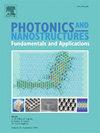High-precision alcohol sensing using twin core photonic crystal fiber
IF 2.5
3区 物理与天体物理
Q3 MATERIALS SCIENCE, MULTIDISCIPLINARY
Photonics and Nanostructures-Fundamentals and Applications
Pub Date : 2025-02-01
DOI:10.1016/j.photonics.2024.101348
引用次数: 0
Abstract
A novel twin-core photonic crystal fiber (TC-PCF) sensor for alcohol detection has been introduced that specifically targets ethanol, propanol, butanol and pentanol. The sensor utilizes silica as a substrate material with circular air holes in the cladding region and operates between 2 µm and 3 µm range of wavelength. Simulations and evaluations are performed on COMSOL Multiphysics software interface. The twin core structure of this sensor contributes to its enhanced or high-precision sensitivity, and the TC-PCF is versatile, making it suitable for detecting four different types of alcohol. This sensor reveals exceptional wavelength sensitivities of 8383.168 nm/RIU, 13759.69 nm/RIU and 14554.26 nm/RIU for ethanol, propanol and butanol respectively for the fiber length of 1600 µm. The amplitude sensitivity for ethanol, propanol, and butanol are 2.95 RIU−1, 5.16 RIU−1 and 5.82 RIU−1 respectively, while the corresponding resolutions for ethanol, propanol and butanol are 119.2 × 10−7 RIU, 72.6 × 10−7 RIU and 68.7 × 10−7 RIU respectively. The figures of merit (FOM) are 29.50 RIU−1, 46.19 RIU−1 and 53.26 RIU−1 for ethanol, propanol and butanol respectively. The sensor offers high sensitivity, a compact design and ease of fabrication which offers significant advantages over traditional alcohol detection methods, making it highly suitable for future alcohol sensing applications.
求助全文
约1分钟内获得全文
求助全文
来源期刊
CiteScore
5.00
自引率
3.70%
发文量
77
审稿时长
62 days
期刊介绍:
This journal establishes a dedicated channel for physicists, material scientists, chemists, engineers and computer scientists who are interested in photonics and nanostructures, and especially in research related to photonic crystals, photonic band gaps and metamaterials. The Journal sheds light on the latest developments in this growing field of science that will see the emergence of faster telecommunications and ultimately computers that use light instead of electrons to connect components.

 求助内容:
求助内容: 应助结果提醒方式:
应助结果提醒方式:


